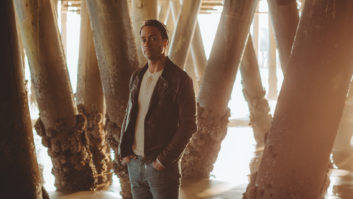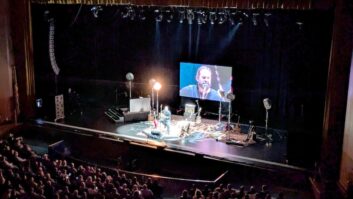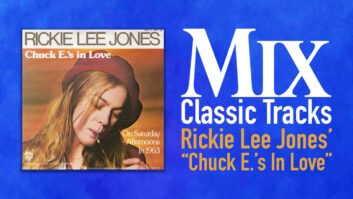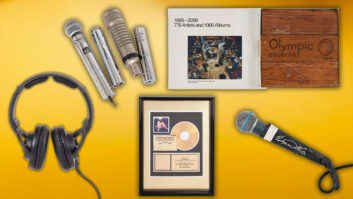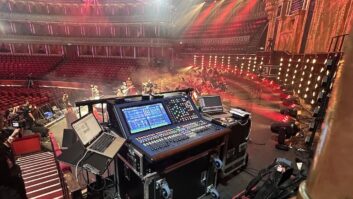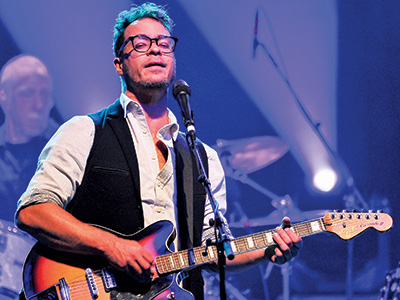
Over the course of an Amos Lee show, fans will get a taste of nearly everything—his delicate and haunting hits like “Arms of a Woman,” a bluegrass or old-timey number or two such as the classic “Will the Circle Be Unbroken,” the infectious folk-rock of “Windows are Rolled Down,” or the soul of songs like “Vaporize.” Mix caught the Bay Area show at the Fox Theater Oakland in late October; the tour continues through March.
Mixing the excellent-sounding show, on the heels of the artist’s release of the self-produced Spirit, are BJ Pendleton at FOH and Drew Consalvo at monitors; Consalvo has also taken over as the production manager and quickly emphasizes that one of the things that makes this tour unique is the close working relationship he has with Pendleton: “I’ve worked with a lot of engineers, but seeing someone get personally, hands-on involved with it to the degree BJ does and the fact that he’s concerned with not only what he’s doing and delivering to the audience, but with how it feels up on the deck based on what he is doing, is kind of a rare thing in this day and age.”
Pendleton, who got his start mixing bands in high school while playing bass, lives in Charlottesville, Va., and got the gig with Lee through contacts with nearby Red Light Management. For this tour, he is mixing on a Yamaha CL5 console.
“The reason I’ve always liked the Yamaha format is it’s simple and straight-ahead,” Pendleton says. “I don’t have to spend a lot of time getting things built and patched; it’s streamlined so that whenever I had my five different jobs I used to do, I didn’t have to worry about the desk. I enjoy its sound quality, knowing all the little Yamaha quirks. The premium rack is one of my favorite parts of it, with all the Neve stuff built in.”
Pendleton doesn’t carry any outboard gear, and keeps his use of plugins as consistent as possible from song to song.
“I’m constantly touching faders and EQ and doing little things, so the mix is always evolving along with the music,” he explains. “I use the Portico 5043 compressor on Amos and several other inputs and outputs. I tend to use my subgroups a lot to help me get more control over the channel, so I route his voice through one of my subgroups, and I have a parametric beyond the one that’s just on the channel strip on that subgroup. It gives me more ways to fine-tune it, especially in different rooms.”
The goal for Pendelton’s mix is what he likes to call a “low-volume, high-fidelity show. It should be pleasing, rather than feeling like you have to leave the room or wear earplugs.”
The tour used house-provided racks and stacks, but Pendleton does system tuning from the CL5.

Front-of-house engineer BJ Pendleton at the Yamaha CL5 board.
“I can have my router hooked up to the desk, and I tend to work with the parametric EQs on my matrix outputs and also the insertable parametric EQs that I can use,” he says. I just go through each zone on the matrixes and do some really fine-tune EQ. I can also go to the output stage on the CL5 with the iPad, so it allows me to do time alignment; I can get right up in the face of the speaker and slowly walk the room and listen to some music.”
Consalvo, who has been mixing since the ’80s, got the gig with Lee through referrals, but found it interesting that Lee called him personally; Consalvo didn’t know he was talking to the artist at first.
“I got a call from some guy who said, ‘Hey, this is Amos, I wanted to talk to you a bit about you doing production management and monitors,’” he recalls. “I had no idea who I was talking to and after about 10 minutes of the conversation it dawned on me that I was speaking to the artist. I stopped the conversation, and explained that with all due respect I didn’t know who I was speaking to, and he seemed to find that kind of refreshing, and introduced himself, explained he was a singer/songwriter and had a large band he was going out with, and suggested I go on YouTube and listen to some of his stuff and then talk to him later about whether it was something I’d be interested in.”

Drew Consalvo mixes monitors on an Avid Profile.
Like his cohort at FOH, Consalvo went out on the tour in 2016 with something familiar, an Avid Profile, as he has used it for many years.
“What I like about that desk is its ubiquitous nature, and the fact that I’ve been using it for some years so muscle memory is there,” he says. “As a monitor engineer, having your hands go where you need them to go when you need them to is really important. I do like its user interface and its ease of use.”
For the early 2017 portion of the tour, Consalvo planned to switch to Avid’s latest, the S6L. “Seeing some of the things I could do with that machine, especially scene-based operation versus the Profile, it became apparent to me and got me chomping at the bit to get my hands on it.”
Most of Lee’s band is on in-ears, using Sennheiser 2000s for the receiver and transmitter and JH Audio in-ear monitors. Consalvo himself uses JH Audio Roxannes to listen to his mixes. However, Lee and multi-instrumentalist Zach Djanikian use wedges. For 2017, Consalvo switched to the d&b M2 after using the M4 in 2016.
Mics included a wide range of Shures, such as SM57s for snare and pedal steel guitar, KSM132s for electric guitars, and KSM9s for vocals, and an Audio-Technica AT4050 for the old-timey part of the show around a single microphone, though that was backed by Neumann KM 184 mics down low for mandolin and banjo. Lee uses a DPA d:facto vocal mic, which gives pristine vocals, but as the volume crept up over the course of the 2016 tour, it presented Consalvo with a challenge, a challenge later solved by providing Lee three wedges on two mixes.
“[The d:facto] is a chore when we get really loud in the wedges, so it takes a steady hand and nerves of steel,” Consalvo says. “It’s an amazing-sounding product, but when we get going, it can get a little demanding. I’m a scene-based mixer, so I will respond to artist’s preference song to song. The ear mixes are set, and I do some touch-up work, but Amos’ stuff I pretty much mix live. Once we get the in-ear mixes dialed and set, I mix Amos live all the time, and because the musical content is so wide-ranging, I have wildly different levels for his acoustic guitar on solo stuff vs. when he’s really digging into it. It’s about laying in on a particular set of faders and getting his mix balanced just right.”
